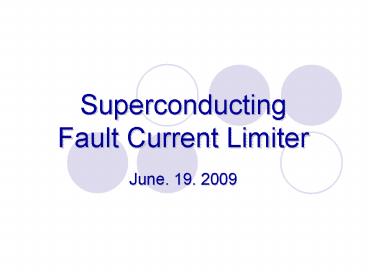Superconducting - PowerPoint PPT Presentation
1 / 23
Title:
Superconducting
Description:
... inductive winding coil transfers to. normal state. The ... no influence on the normal. operation of the DC system. the flux in iron core f is compensated zero ... – PowerPoint PPT presentation
Number of Views:990
Avg rating:3.0/5.0
Title: Superconducting
1
Superconducting Fault Current Limiter
June. 19. 2009
2
Introduction
3
Fault Current Limiter
function of Fault Current Limiter
in normal state
pass an electric current with little loss
in fault state
suppress the fault current in a moment
4
Operation of Fault Current Limiter
FCL
5
Type of Fault Current Limiter
6
Superconducting Fault Current Limiter
7
Superconducting Fault Current Limiter
8
SFCL of S/N transition type(1)
principle of resistive type
normal state
fault state
I lt Ic
large current
I gt Ic
S/N transition
SC (R ? 0)
SC (large R value)
superconducting state
normal state
9
SFCL of S/N transition type(2)
principle of non-inductive winding type
When the fault is occurred, the fault
current flows in the system.
The non-inductive winding coil transfers
to normal state.
The value of I2 decreases rapidly.
Increased I1 flows into the current-limiting
reactor.
current limiting
10
SFCL of S/N transition type(3)
principle of magnetic shielding type
normal state
The SC cylinder is superconducting state.
magnetic shielding effect
Meissner effect
fault state
The fault current is occurred.
The SC cylinder transfers to normal state.
Magnetic shielding effect is broken.
high inductance
11
Problem
for realization of power technology applied
superconducting
develop
furthermore
needs of equipment research and development for
the power system considered actual operation
to aim at the efficiency improvement as all
superconducting power systems
It is very important to unify equipments and
cooling condition.
12
Active superconducting DC fault current limiter
based on flux compensation
Jing Shi, Yuejin Tang, Chen Wang, Yusheng Zhou,
Jingdong Li, Li Ren, Shijie Chen
13
Introduction
active superconducting DC fault current limiter
(DC-SFCL) based on flux compensation
14
Analytical model
Main circuit of the active DC-SFCL
15
Principle of flux compensation
Circuit of the superconducting transformer
Equivalent circuit of the transformer
16
Principle of fault current-limiting(1)
17
Principle of fault current-limiting(2)
neglect the influence
Equivalent circuit of the DC-SFCL
18
Principle of dynamic reactive power compensation
PWM converter
function of controlling power exchange
the active and reactive component can be
controlled independently
the reactive current
the active current
Principle of reactive compensation
improve the operation performance of system
19
Simulation results(1)
about 10 times
about 2 times
30 A
0 Wb
pac
The active DC-SFCL operation waveforms
20
Simulation results(2)
DC-SFCL
the active power exchange
regulating the magnitude of active power transfer
the fault current can be controlled to different
levels
The effect of fault current-limiting
21
Simulation results(3)
The reactive power compensation of DC-SFCL
22
Conclusion
The performance of the active DC-SFCL based
on flux compensation is confirmed.
no influence on the normal operation of the
DC system
respond to the reactive power demand of the
AC system quickly
suppress to different levels and normal
operation level quickly
the experimental study
23
References
? ????,??????????,???? (2006)
? ?????????? http//www.kyuden.co.jp/service_t
ech_sales_sales18.html
? ????????????????? http//www.okubo.nuee.nago
ya-u.ac.jp/detail_sfclt_j.html





![[PPT] Superconducting Wire Market May See a Big Move PowerPoint PPT Presentation](https://s3.amazonaws.com/images.powershow.com/9904162.th0.jpg?_=20230706073)

























